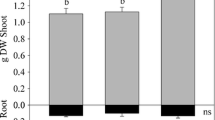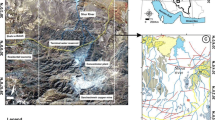Abstract
Nanoparticle (NPs) toxicity in the plant has drawn considerable attention. Fenugreek plants were cultivated for 16 days in hydroponic experiments and treated with 50 and 100 mg L− 1 titanium oxide (TiO2) NPs of two sizes [23 ± 1.6 nm (D1) and 83 ± 15 nm. (D2)]. The level of Ti in roots was higher than that of leaves and stems of plants treated with 100 mg L− 1 of TiO2 NPs (D1, D2). Ti caused a depletion of Ca and Mn compared with root control. The titane (Ti) damage to root cellular membranes could alter the plant’s capacity to absorb and transport some nutrients. In our study, increasing the size of TiO2 NPs produced increases in the contents of Mg, Zn and Mn, and a decline in the contents of Fe and Cu in leaves and stems. In roots, Fe and Cu decreased after TiO2 NPs (D2) exposure. Changes in the fenugreek plant mineral composition were assessed, and physiological disturbances could be directly correlated with exposure to NPs.




Similar content being viewed by others
Change history
24 February 2021
A Correction to this paper has been published: https://doi.org/10.1007/s00128-021-03102-0
References
Anjum NA, Gill SS, Duarte AC et al (2013) Silver nanoparticles in soil–plant systems. J Nanopart Res 15:1–26
Antisari LV, Ventura F, Simoni A et al (2013) Assessment of pollutants in wet and dry depositions in a suburban area around a waste-to-energy plant (WEP) in Northern Italy. J Environ Prot 4:16–25
Aslani F, Bagheri S, Julkapli NM et al (2014) Effects of engineered nanomaterials on plants growth: an overview. Sci World J 2014:1–28
Asli S, Neumann PM (2009) Colloidal suspensions of clay or titanium dioxide nanoparticles can inhibit leaf growth and transpiration via physical effects on root water transport. Plant Cell Environ 32:577–584
Battke F, Leopold K, Maier M et al (2008) Palladium exposure of barley: uptake and effects. Plant Biol 10:272–276
Bellani L, Siracusa G, Giorgetti L et al (2020) TiO2 nanoparticles in a biosolid-amended soil and their implication in soil nutrients, microorganisms and Pisum sativum nutrition. Ecotoxicol Environ Saf 190:110095
Birbaum K, Brogioli R, Martinoia E, Stark WJ (2010) No evidence for cerium dioxide nanoparticle translocation in maize plants. Environ Sci Technol 44:8718–8723
Blinova I, Ivask A, Heinlaan M et al (2010) Ecotoxicity of nanoparticles of CuO and ZnO in natural water. Environ Pollut 158:41–47
Buick RD, Buchanb GD, Fielda RJ (1993) The role of surface tension of spreading drodets in absorption of a herbicide formulation via leaf stomata. Pestic Sci 38:227–235
Cam Tourinho PS., Gestel V, Lofts S et al (2012) Metal-based nanoparticles in soil: fate, behavior, and effects on soil invertebrates. Environ Toxicol Chem. https://doi.org/10.1002/etc.1880
Corredor E, Testillano PS, Coronado M et al (2009) Nanoparticle penetration and transport in living pumpkin plants: in situ subcellular identification. BMC Plant Biol 9:1–11
Dietz K, Herth S (2011) Plant nanotoxicology. Trends Plant Sci 16:582–589
Etxeberria E, Gonzalez P, Pozueta J (2009) Evidence for two endocytic transport pathways in plant cells. Plant Sci 177:341–348
Gardea-torresdey JL, Rico CM, White JC (2014) Trophic transfer, transformation, and impact of engineered nanomaterials in terrestrial environments. Env Sci Technol 48:2526–2540
Haider J, Anbari A-, Corre O, Le, Ferrão P (2017) Exploring potential environmental applications of TiO2 nanoparticles assessing the feasibility of using the heat demand-outdoor temperature function for a long-term district heat demand forecast. Energy Procedia 119:332–345
Ismael M (2020) Engineering enhanced photocatalytic hydrogen production and degradation of organic pollutants from Fe (III) doped TiO2 nanoparticles. J Environ Chem Eng 8:103676
Ju-nam Y, Lead JR (2008) Manufactured nanoparticles: an overview of their chemistry, interactions and potential environmental implications. Sci Total Environ 400:396–414. https://doi.org/10.1016/j.scitotenv.2008.06.042
Klaine SJ, Alvarez PJJ, Batley GE et al (2008) Nanomaterials in the environment: behavior, fate, bioavailability, and effects. Environ Toxicol Chem 27:1825–1851
Kurepa J, Paunesku T, Vogt S et al (2010) Uptake and distribution of ultrasmall anatase TiO2 alizarin red s nanoconjugates in arabidopsis thaliana. Nano Lett 10:2296–2302
Larue C (2012) TiO2 nanoparticle and carbon nanotube impact on plants to obtain the degree of doctor delivered by the institute of sciences and industries of the living and the environment (AgroParisTech) specialty: ecotoxicology/environment, p 289
Lee WM, An YJ, yoon H, kweon HS (2008) toxicity and bioavailability of copper nanoparticles to the terrestrial plants mung bean (phaseolus radiatus) and wheat (triticum aestivum): plant agar test for water-insoluble nanoparticles woo-mi. Environ Toxicol Chem 27:1915–1921
Lin D, Xing B (2008) Root uptake and phytotoxicity of ZnO nanoparticles. Environ Sci Technol 42:5580–5585
Lin S, Reppert J, Hu Q et al (2009) Uptake, translocation, and transmission of carbon nanomaterials in rice plants. Small Nano Micro. https://doi.org/10.1002/smll.200801556
Lopez-Moreno ML, de la Rosa G, Hernandez-Viezcas JA, Castillo-Michel H et al (2010) Evidence of the differential biotransformation and genotoxicity of ZnO and CeO2 Nanoparticles on Soybean (Glycine max) plants. Environ Sci Technol 44:7315–7320
Ma C, White JC, Dhankher OP, Xing B (2015) Metal-based nanotoxicity and detoxi fi cation pathways in higher plants. Environ Sci Technol 49:7109–7122
Mandeh M, Omidi M, Rahaie M (2012) In vitro influences of TiO2 nanoparticles on Barley (Hordeum vulgare L.) tissue culture. Biol Trace Elem Res 150:376–380
Meng H, Xia T, George S, Nel AE (2009) A predictive toxicological paradigm for the safety assessment of nanomaterials. ACS Nano 3:1620–1627
Miralles P, Church TL, Harris AT (2012) Toxicity, uptake, and translocation of engineered nanomaterials in vascular plants. Environ Sci Technol 46:9224–9239
Missaoui T, Smiri M, Chmingui H, Hafiane A (2017) Effects of nanosized titanium dioxide on the photosynthetic metabolism of fenugreek (Trigonella foenum-graecum L.). Comptes Rendus Biol 340:499–511
Missaoui T, Smiri M, Chemingui H et al (2018) Regulation of mitochondrial and cytosol antioxidant systems of fenugreek (Trigonella foenum graecum L.) exposed to nanosized titanium dioxide. Bull Environ Contam Toxicol 101:326–337
Nair R, Varghese SH, Nair BG et al (2010) Nanoparticulate material delivery to plants. Plant Sci 179:154–163. https://doi.org/10.1016/j.plantsci.2010.04.012
Nowack B, Bucheli TD (2007) Occurrence, behavior and effects of nanoparticles in the environment. Environ Pollut 150:5–22
Pérez-de-Luque A (2017) Interaction of nanomaterials with plants: what do we need for real applications in agriculture? Front Environ Sci 5:1–17
Priester JH, Ge Y, Mielke RE et al (2012) Soybean susceptibility to manufactured nanomaterials with evidence for food quality and soil fertility interruption. PNAS Plus 109:14734–14735
Rico CM, Morales MI, Barrios AC et al (2013) Effect of cerium oxide nanoparticles on the quality of rice (Oryza sativa L.) grains. J Agric Food Chem 61:11278–11285
Rui M, Ma C, White JC et al (2018) Metal oxide nanoparticles alter peanut (Arachis hypogaea L.) physiological response and reduce nutritional quality : a life cycle study. Environ Sci Nano 5:2088–2102
Servin A, Morales MI, Castillo-michel H et al (2013) Synchrotron verification of TiO2 accumulation in cucumber fruit: A possible pathway of TiO2 nanoparticle transfer from soil into the food chain environmental science and engineering PhD program, The University of Texas at El. Environ Sci Technol 47:11592–11598
Shoults-wilson WA, Reinsch BC, Tsyusko OV et al (2010) Effect of silver nanoparticle surface coating on bioaccumulation and reproductive toxicity in earthworms (Eisenia fetida). Nanotoxicology 5:432
Trujillo-Reyesa J, Peralta-Videaa JR, Majumdar S et al (2014) Exposure studies of core-shell Fe/Fe3O4 and Cu/CuO NPs to lettuce (Lactuca sativa) plants: are they a potential physiological and nutritional hazard? J Hazard Mater 267:255–263
Wang J, Zhu X, Zhang X et al (2011) Disruption of zebrafish (Danio rerio) reproduction upon chronic exposure to TiO2 nanoparticles. Chemosphere 83:461–467
Wang Z, Xie X, Zhao J et al (2012) Xylem- and phloem-based transport of CuO nanoparticles in maize (Zea mays L.). Environ Sci Technol 46:4434–4441
Wang P, Menzies NW, Lombi E et al (2013) Fate of ZnO nanoparticles in soils and Cowpea (Vigna unguiculata). Environ Sci Technol 47:13822–13830
Wu J, Qiu H, Yang G et al (2003) Nutrient uptake of rice roots in response to infestation of Nilaparvata lugens (Stål) (Homoptera: Delphacidae). J Econ Entomol 96:1798–1804
Zhang W, Hughes J, Chen Y (2012) Impacts of hematite nanoparticle exposure on biomechanical. Appl Environ Microbiol 78:3905–3915
Zhang P, Ma Y, Zhang Z (2015) Interactions between engineered nanomaterials and plants: phytotoxicity, uptake, translocation, and biotransformation. nanotechnology and plant sciences. Springer, Cham, pp 77–99
Author information
Authors and Affiliations
Corresponding author
Additional information
Publisher's Note
Springer Nature remains neutral with regard to jurisdictional claims in published maps and institutional affiliations.
The original online version of this article was revised: the incorrect author names has been corrected in the author group along with the affiliation.
Rights and permissions
About this article
Cite this article
Missaoui, T., Smiri, M., Chemingui, H. et al. Disturbance in Mineral Nutrition of Fenugreek Grown in Water Polluted with Nanosized Titanium Dioxide. Bull Environ Contam Toxicol 106, 327–333 (2021). https://doi.org/10.1007/s00128-020-03051-0
Received:
Accepted:
Published:
Issue Date:
DOI: https://doi.org/10.1007/s00128-020-03051-0




